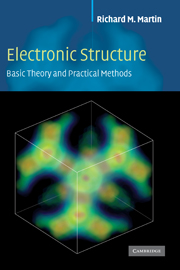Book contents
- Frontmatter
- Contents
- Preface
- Acknowledgments
- Notation
- Part I Overview and background topics
- Part II Density functional theory
- Part III Important preliminaries on atoms
- Part IV Determination of electronic structure: the three basic methods
- Part V Predicting properties of matter from electronic structure – recent developments
- Appendix A Functional equations
- Appendix B LSDA and GGA functionals
- Appendix C Adiabatic approximation
- Appendix D Response functions and Green's functions
- Appendix E Dielectric functions and optical properties
- Appendix F Coulomb interactions in extended systems
- Appendix G Stress from electronic structure
- Appendix H Energy and stress densities
- Appendix I Alternative force expressions
- Appendix J Scattering and phase shifts
- Appendix K Useful relations and formulas
- Appendix L Numerical methods
- Appendix M Iterative methods in electronic structure
- Appendix N Code for empirical pseudopotential and tight-binding
- Appendix O Units and conversion factors
- References
- Index
Part IV - Determination of electronic structure: the three basic methods
Published online by Cambridge University Press: 05 June 2012
- Frontmatter
- Contents
- Preface
- Acknowledgments
- Notation
- Part I Overview and background topics
- Part II Density functional theory
- Part III Important preliminaries on atoms
- Part IV Determination of electronic structure: the three basic methods
- Part V Predicting properties of matter from electronic structure – recent developments
- Appendix A Functional equations
- Appendix B LSDA and GGA functionals
- Appendix C Adiabatic approximation
- Appendix D Response functions and Green's functions
- Appendix E Dielectric functions and optical properties
- Appendix F Coulomb interactions in extended systems
- Appendix G Stress from electronic structure
- Appendix H Energy and stress densities
- Appendix I Alternative force expressions
- Appendix J Scattering and phase shifts
- Appendix K Useful relations and formulas
- Appendix L Numerical methods
- Appendix M Iterative methods in electronic structure
- Appendix N Code for empirical pseudopotential and tight-binding
- Appendix O Units and conversion factors
- References
- Index
Summary
There are nine and sixty ways of constructing tribal lays, And every single one of them is right!
Rudyard Kipling, In the Neolithic AgeOverview of Chapters 12–17
There are three basic approaches to the calculation of independent-particle electronic states in materials. There are no fundamental disagreements: all agree when applied carefully and taken to convergence. Indeed, each of the approaches leads to instructive, complementary ways to understand electronic structure and each can be developed into a general framework for accurate calculations.
Each method has its advantages: each is most appropriate for a range of problems and can provide particularly insightful information in its realm of application.
Each method has its pitfalls: the user beware. It is all too easy to make glaring errors or over-interpret results if the user does not understand the basics of the methods.
The three types of methods and their characteristic pedagogical values are:
1. Plane wave and grid methods provide general approaches for solution of differential equations, including the Schrödinger and Poisson equations. At first sight, plane waves and grids are very different, but in fact each is an effective way of representing smooth functions. Furthermore, grids are involved in modern efficient plane wave calculations that use fast Fourier transforms.
Chapter 12 is devoted to the basic concepts and methods of electronic structure. Plane waves are presented first because of their simplicity and because Fourier transforms provide a simple derivation of the Bloch theorem.
- Type
- Chapter
- Information
- Electronic StructureBasic Theory and Practical Methods, pp. 233 - 235Publisher: Cambridge University PressPrint publication year: 2004
- 1
- Cited by



